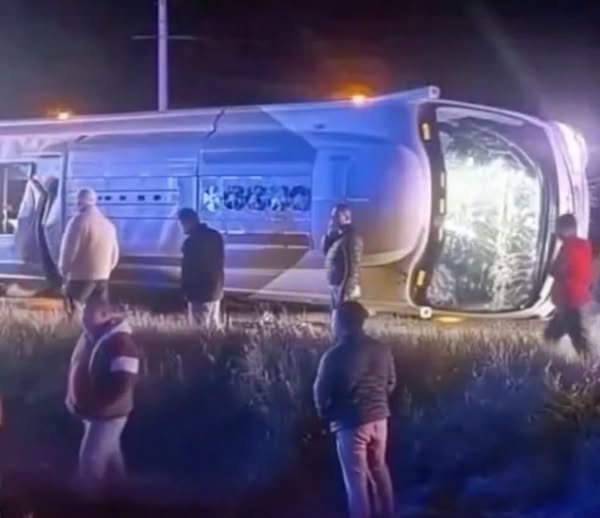A devastating chain of collisions on the Mexico-Querétaro Highway has left at least 19 people dead and several others injured, according to early reports from local authorities. The tragic event unfolded late Wednesday morning, November 20, near the Huehuetoca municipality in the State of Mexico, forcing a complete shutdown of one of the country’s busiest transportation corridors.
A Catastrophic Scene at Kilometer 59
Authorities confirmed that the first major crash occurred at kilometer 59+000, just south of the Jorobas interchange — a stretch notorious for its steep inclines and heavy truck traffic. A large cargo trailer, traveling toward Mexico City, reportedly lost control after failing to brake in time. The truck plowed into several vehicles ahead before overturning and skidding across the asphalt, blocking all three north-south lanes.
The impact triggered a chain reaction involving at least five private cars and one pickup truck. Eyewitnesses described a horrifying scene of twisted metal, shattered glass, and debris scattered across the highway. Some vehicles were crushed beyond recognition.
“The trailer came down too fast — I could see its brakes smoking,” said driver Mario Gutiérrez, who narrowly escaped the pileup. “When it hit the first car, everything went black. The sound was like an explosion.”
Emergency sirens echoed for miles as firefighters, paramedics, and civil protection units rushed to the site. Authorities quickly set up a security perimeter and diverted traffic to service roads, but by then, massive delays had formed in both directions.
Investigators Examine What Went Wrong
Early reports suggest that weather conditions may have played a critical role. Heavy rains overnight left the asphalt slick, reducing tire traction and increasing braking distance. The trailer’s driver, who survived but remains hospitalized under police custody, told investigators that his brakes “gave out” just before impact.
Officials from the Federal Highway Police and the State Attorney General’s Office have opened a formal investigation into the cause of the collision. They will examine whether poor vehicle maintenance, driver fatigue, excessive speed, or mechanical failure contributed to the crash.
“The first 48 hours are crucial,” said Commander Héctor Morales of the highway patrol unit. “We’ll be reviewing the truck’s onboard computer, brake systems, and the driver’s rest log to determine exactly what caused this tragedy.”
Authorities are also evaluating whether the highway’s design and drainage systems may have exacerbated the incident. Huehuetoca’s section of the Mexico-Querétaro route is known for high freight traffic, sharp curves, and reduced visibility during rainfall — conditions that have contributed to previous accidents.
Response and Recovery Efforts
By early afternoon, at least twelve ambulances and multiple rescue units from nearby municipalities — including Cuautitlán, Tepotzotlán, and Zumpango — were deployed to assist victims. Paramedics provided on-site triage for survivors suffering from cuts, fractures, and shock. A few were airlifted to regional hospitals for further evaluation.
Forensic teams worked into the evening to identify victims and recover remains from the wreckage. As night fell, tow trucks began clearing mangled vehicles while cleanup crews worked to remove spilled fuel and debris from the roadway. Traffic authorities urged motorists to avoid the area entirely, warning of hours-long delays extending north toward Querétaro and south into the capital.
Fuel Spill and Secondary Accidents Worsen Chaos
Compounding the day’s disaster, a second accident occurred roughly 35 kilometers away, near Soyaniquilpan de Juárez. There, a tanker truck overturned and ruptured its tank, spilling thousands of liters of fuel across all lanes at kilometer 95.5 of the same highway. Authorities closed the section completely to prevent ignition and potential explosions.
Hazmat teams and firefighters from the State of Mexico’s emergency services raced to contain the spill, deploying foam barriers and sand to neutralize the volatile liquid. Traffic in the area ground to a halt for hours, stranding hundreds of vehicles along the highway.
The dual incidents paralyzed one of Mexico’s most vital commercial arteries, which carries goods and passengers between the capital and the industrial heartlands of Querétaro, Guanajuato, and beyond.
Eyewitness Accounts Paint a Grim Picture
For those caught in the chaos, the experience was harrowing. Witnesses described confusion, panic, and acts of heroism amid the devastation.
“I saw a man break his car window with a fire extinguisher to pull a woman out,” said commuter Elena Ramos, who was trapped for nearly three hours before being rerouted. “People were screaming. You could smell fuel everywhere. It was terrifying.”
Another witness, trucker José Velázquez, said he’d noticed the trailer speeding minutes before the crash. “He was overloaded and coming down the slope too fast. Everyone honked to warn him. He must’ve realized too late.”
Local residents living near the highway also reported hearing a thunderous boom followed by a series of smaller explosions as vehicles ignited. “The sound shook the ground,” said homeowner Luis Ortega. “We ran outside and saw flames rising into the sky.”
Authorities Urge Caution Amid Dangerous Road Conditions
Following the deadly collision, Mexico’s Secretariat of Infrastructure, Communications, and Transportation (SICT) issued an urgent advisory reminding drivers to reduce speed during rain and maintain safe distances. Officials emphasized that the Mexico-Querétaro route has become increasingly perilous due to heavy cargo traffic, inadequate enforcement of rest-hour regulations, and deteriorating road conditions.
“This tragedy underscores the urgent need to modernize braking systems in long-haul trucks and to increase monitoring of driver fatigue,” said transportation analyst Carla Pineda. “We can’t keep calling these ‘accidents’ when the same patterns repeat year after year.”
Highway patrol officers have increased surveillance and installed temporary checkpoints to inspect trucks for overloading and brake functionality. Meanwhile, federal and state agencies are coordinating to reopen the blocked lanes as soon as the wreckage is cleared and the surface deemed safe.
Community in Mourning
By Thursday morning, the full magnitude of the disaster began to sink in. Flags in Huehuetoca and nearby municipalities were lowered to half-staff, and local churches held evening vigils for the victims. Families gathered outside morgues, waiting anxiously for confirmation of their loved ones’ identities.
Among the dead were commuters returning from night shifts, a family of four heading to Mexico City, and two college students en route to Querétaro for exams. “They were young, full of dreams,” said a relative of one of the victims. “They didn’t deserve this.”
President Andrés Manuel López Obrador expressed condolences during his morning press briefing, calling the accident “a painful reminder of the human cost of our transportation challenges.” He pledged federal support for victims’ families and ordered a comprehensive review of freight safety standards on national highways.
A Tragic Reminder
The Mexico-Querétaro Highway, one of the country’s busiest and most economically vital routes, has long been plagued by fatal collisions — often involving cargo trailers. This latest tragedy has reignited public debate over highway safety, driver regulation, and infrastructure investment.
For now, investigators continue combing through evidence: skid marks, dashcam footage, and witness testimony. The final report will determine whether mechanical failure, driver negligence, or infrastructure flaws were to blame.
But for the families mourning loved ones, no investigation will undo what was lost. The stretch of asphalt at kilometer 59 now stands as another grim reminder of the fragility of life and the urgent need for reform on Mexico’s roads.


